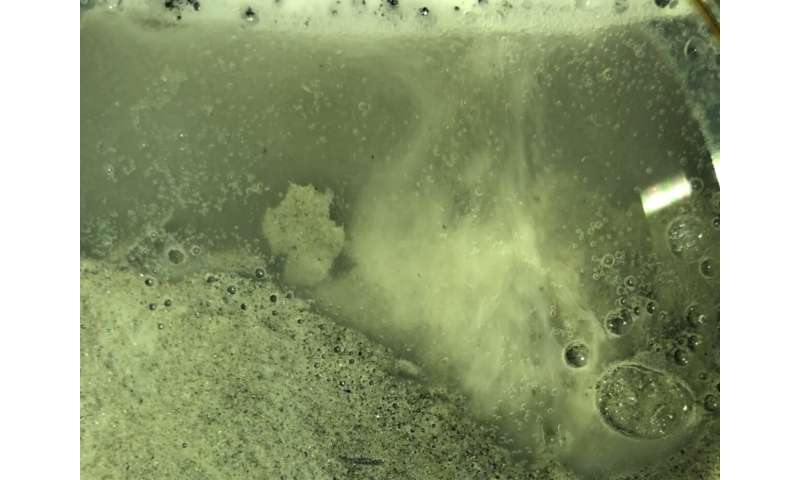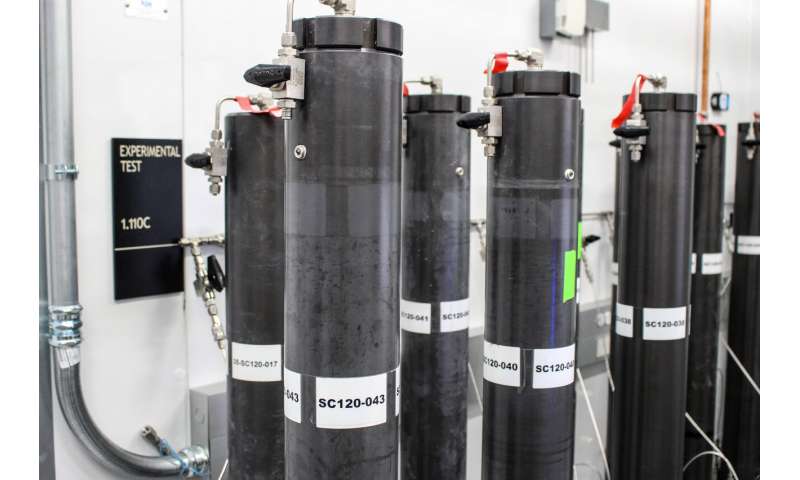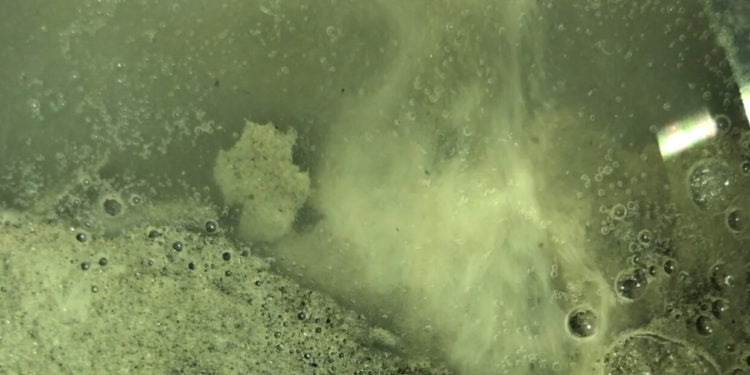[ad_1]

New analysis from The College of Texas at Austin has defined an necessary thriller about pure fuel hydrate formations and, in doing so, superior scientists’ understanding of how fuel hydrates might contribute to local weather change and vitality safety.
The analysis used a pc mannequin of fuel bubbles flowing by hydrate deposits, a standard phenomenon which in keeping with current fashions, shouldn’t be potential based mostly on physics. The brand new mannequin helps clarify how some deposits develop into huge pure fuel hydrate reservoirs, corresponding to these discovered beneath the Gulf of Mexico.
A paper describing the analysis was revealed Feb.16, 2020, within the journal Geophysical Analysis Letters.
Fuel hydrates are an icy substance wherein fuel molecules, usually methane, change into trapped in water-ice cages underneath excessive stress and low temperature. They’re discovered extensively in nature, home a considerable fraction of the world’s natural carbon and will change into a future vitality useful resource. Nonetheless, many questions stay about how hydrate deposits type and evolve.
One such query was raised by observations within the area which noticed methane flowing freely as a fuel by hydrate deposits within the subsurface. What puzzled scientists is that underneath situations the place hydrates happen, methane ought to solely exist as a hydrate, not as a free fuel. To resolve the thriller of the free flowing fuel, a crew of UT researchers led by Dylan Meyer, a graduate scholar on the UT Jackson Faculty of Geosciences, recreated within the lab what they noticed within the area.
Utilizing this knowledge, they hypothesized that as hydrate types in a deposit it additionally acts as a barrier between fuel and water, limiting the velocity at which new hydrate types, and permitting a lot of the fuel to bubble by the deposit. They developed this concept into a pc mannequin and located that the mannequin matched experimental outcomes. When scaled up, additionally they matched proof from area research, making it the primary mannequin of the phenomena to efficiently do each. Crucially, the mannequin means that fuel flowing by the subsurface can accumulate into massive, concentrated hydrate reservoirs, which might be appropriate targets for future vitality sources.
“The mannequin convincingly reproduces a variety of impartial experimental outcomes, which strongly help the basic ideas behind it,” mentioned Meyer. “We imagine this mannequin will probably be a vital device for future research investigating the evolution of enormous, extremely concentrated hydrate reservoirs that have comparatively fast fuel circulate by porous media.”

The research is the primary time this sort of mannequin has been constructed utilizing knowledge from experiments designed to imitate the fuel circulate course of. The crew produced their very own hydrate deposit within the lab utilizing a combination of sand, water and fuel and recreating the acute situations present in nature. Their efforts supplied them with reasonable and related knowledge from which to develop their mannequin.
Co-author Peter Flemings, a professor on the Jackson Faculty, mentioned that understanding how methane fuel travels by hydrate layers within the subsurface is necessary for understanding methane’s position within the carbon cycle and its potential contribution to world warming.
“The paper provides a chic and easy mannequin to elucidate some very difficult experiments,” mentioned Flemings.
The research’s experiments have been carried out in specialised labs on the Jackson Faculty, however the mannequin was the results of a cross-campus collaboration between two UT faculties, the Jackson Faculty and the Cockrell Faculty of Engineering.
Meyer, Flemings and Kehua You, a analysis scientist on the College of Texas Institute for Geophysics (UTIG), had developed the unique pc code to elucidate their experimental outcomes, nevertheless it wasn’t till they teamed up with David DiCarlo, an affiliate professor on the the UT Cockrell Faculty of Engineering, who confirmed them how the outcomes might be offered utilizing analytical math, that they might efficiently sort out the issue in a method that mirrored what they have been seeing in nature.
The paper is the fruits of Meyer’s graduate analysis and builds on two beforehand revealed papers that centered on the outcomes of his lab experiments. Meyer graduated in 2018 with a doctoral diploma from the Jackson Faculty and is now a postdoctoral researcher at Academia Sinica in Taipei.
The analysis was funded by the U.S. Division of Power (DOE) and is a part of a broader partnership between the DOE and The College of Texas at Austin to research methane hydrate deposits within the Gulf of Mexico.
Most of the lab experiments that fed into the present research have been carried out by Meyer on the UT Strain Core Heart, a laboratory on the Jackson Faculty geared up to retailer and research pressurized cores taken from pure methane hydrate deposits in 2017 and which stays the one such university-based facility.
Research reveals how you can produce pure fuel whereas storing carbon dioxide
Dylan W. Meyer et al. Fuel Move by Invasion Percolation By means of the Hydrate Stability Zone, Geophysical Analysis Letters (2020). DOI: 10.1029/2019GL084380
Quotation:
Pc mannequin solves thriller of how fuel bubbles construct huge methane hydrate deposits (2020, March 12)
retrieved 12 March 2020
from https://phys.org/information/2020-03-mystery-gas-big-methane-hydrate.html
This doc is topic to copyright. Other than any truthful dealing for the aim of personal research or analysis, no
half could also be reproduced with out the written permission. The content material is supplied for info functions solely.
[ad_2]









